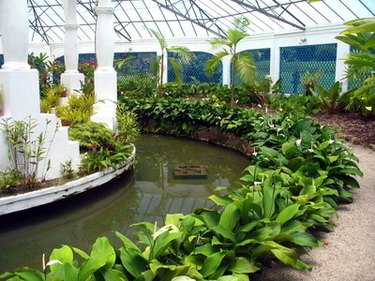
The seeds of floriculture were first planted in Babylonian Times, with the Hanging Gardens of Babylon. A far cry from what is considered modern floriculture involving greenhouses and the nurturing of flowers and other potted plants, the Hanging Gardens were regarded as one of the Seven Ancient Wonders of the World. The first greenhouse was built around A.D. 30 for the Roman emperor Tiberius. The history of floriculture has grown from there.
Mica-House
Video of the Day
In the time of Tiberius, glass had yet to be invented, so the greenhouse was painstakingly constructed from thinly sliced mica to allow the warming effects of the sun to be captured to accommodate the emperor's great liking for out-of-season cucumbers. It wasn't until much later that the Vatican in Rome built the first glasshouse to accommodate new species of plants that were being introduced through trade with faraway lands of dissimilar climate. About 100 years later in the 14th Century another greenhouse was built in Salerno, Italy. Glass had been invented by then, but the greenhouse itself bore little resemblance to the modern greenhouse, and it was rarely used as the incubator we now use for modern floriculture.
Video of the Day
Miracle Grow
It wasn't until 1599 that the first practical greenhouse was designed by Jules Charles, a French botanist. The greenhouse was built in Leiden Holland, primarily to grow medicinal tropical plants and citrus fruits. The first greenhouses were known as orangeries, because of the importation and propagation of orange trees. Greenhouse buildings began to spring up throughout Europe, as trade expanded to lands of diverse climates. They were limited to the aristocratic and upper echelons of society.
The Advent of Modern Day Floriculture
The first greenhouse in the United States was in 1737 by wealthy Boston merchant Andrew Faneuil. However, by 1825, greenhouses were becoming increasingly common, many warmed by furnaces or built into earthen pits with south facing windows, which is a design that remains highly practical today. In 1800, there was one commercial florist known to be in business in the United States. Three more opened between 1810 and 1820. Another eight commercial florists served customers between 1820 and 1830, and 25 more opened in the next decade. No longer were greenhouses limited to the wealthy class. Growing ornamental plants and flowers became popular.
The Early Years
Catherine Gore published her book, "The Rose Fanciers Manual," on floral arrangement in1838. Peter Henderson wrote a detailed book in 1882 on how to build a furnace-heated greenhouse using hot water running through pipes and hinged fluted south-facing windows to regulate temperature. By then, floriculture had established itself as a young but flourishing industry. The industry was even recession-proof as wholesale/retail florist George Didden's start-up greenhouse in Hatfield, Pennsylvania, thrived through the 1930s. While many businesses suffered, Didden's greenhouse floral business boomed, since weddings and funerals continued their use of flowers.
Modern Floriculture
The conventional glass and steel greenhouses gave way to polyvinyl chloride. It was discovered in 1920; by the mid-1940s and 1950s, its uses appeared endless. Polyvinyl chloride became an inexpensive alternative to steel frame greenhouses. With the later introduction of acrylics and plastic film, glasshouses took on entirely different look at a greatly reduced price. Quonset huts could be constructed for home floriculturists at very reasonable prices and in small areas. For most commercial floraculturists, glass remains the covering of choice because of its durability, though many commercial growers use various types of vinyl panels. For the record, the bestselling flower is the chrysanthemum.